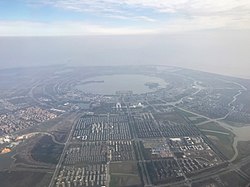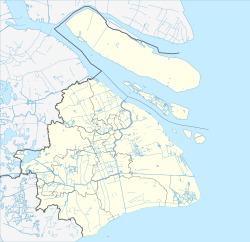Nanhui New City
30°54′N 121°56′E / 30.900°N 121.933°E
This article has multiple issues. Please help improve it or discuss these issues on the talk page. (Learn how and when to remove these messages)
|
Nanhui New City (Chinese: 南汇新城) is a planned city located in the Pudong New Area of Shanghai, China. It was formerly called Lingang New City (临港新城) until it was renamed in April 2012.[1]
Construction began in 2003 and is scheduled to be completed in 2020, with the German architecture company Gerkan, Marg and Partners leading the project. The project is estimated to have cost $4.5 billion. The city is aimed to house 450,000 to 800,000 residents while attracting 10 million annual tourists.[2][3]
Nanhui New City
南汇新城 Nanhwei | |
|---|---|
 Dishui Lake from Above | |
| Coordinates: 30°54′N 121°56′E / 30.900°N 121.933°E | |
| Country | China |
| Municipality | Shanghai |
| District | Pudong |
| Area | |
| • Total | 277.66 km2 (107.21 sq mi) |
| Population | |
| • Total | 600,000 |
| • Density | 2,200/km2 (5,600/sq mi) |
| Time zone | UTC+8 (China Standard Time (CST)) |
Climate
[edit]| Climate data for Nanhui District (1991–2020 normals, extremes 1981–2010) | |||||||||||||
|---|---|---|---|---|---|---|---|---|---|---|---|---|---|
| Month | Jan | Feb | Mar | Apr | May | Jun | Jul | Aug | Sep | Oct | Nov | Dec | Year |
| Record high °C (°F) | 22.1 (71.8) |
25.6 (78.1) |
27.4 (81.3) |
31.7 (89.1) |
34.3 (93.7) |
35.5 (95.9) |
39.0 (102.2) |
38.2 (100.8) |
36.6 (97.9) |
32.2 (90.0) |
27.6 (81.7) |
23.5 (74.3) |
39.0 (102.2) |
| Mean daily maximum °C (°F) | 8.6 (47.5) |
10.2 (50.4) |
13.9 (57.0) |
19.3 (66.7) |
24.2 (75.6) |
27.1 (80.8) |
31.6 (88.9) |
31.3 (88.3) |
27.6 (81.7) |
23.0 (73.4) |
17.8 (64.0) |
11.5 (52.7) |
20.5 (68.9) |
| Daily mean °C (°F) | 4.8 (40.6) |
6.2 (43.2) |
9.8 (49.6) |
14.9 (58.8) |
20.0 (68.0) |
23.7 (74.7) |
28.0 (82.4) |
27.9 (82.2) |
24.2 (75.6) |
19.1 (66.4) |
13.6 (56.5) |
7.3 (45.1) |
16.6 (61.9) |
| Mean daily minimum °C (°F) | 1.8 (35.2) |
3.0 (37.4) |
6.4 (43.5) |
11.2 (52.2) |
16.5 (61.7) |
21.0 (69.8) |
25.3 (77.5) |
25.4 (77.7) |
21.4 (70.5) |
15.7 (60.3) |
10.1 (50.2) |
4.0 (39.2) |
13.5 (56.3) |
| Record low °C (°F) | −7.9 (17.8) |
−6.0 (21.2) |
−4.2 (24.4) |
−0.7 (30.7) |
7.1 (44.8) |
12.7 (54.9) |
18.7 (65.7) |
18.8 (65.8) |
11.5 (52.7) |
1.9 (35.4) |
−1.7 (28.9) |
−7.8 (18.0) |
−7.9 (17.8) |
| Average precipitation mm (inches) | 72.2 (2.84) |
67.9 (2.67) |
97.5 (3.84) |
85.2 (3.35) |
94.0 (3.70) |
211.2 (8.31) |
135.7 (5.34) |
187.8 (7.39) |
126.0 (4.96) |
73.8 (2.91) |
63.7 (2.51) |
54.6 (2.15) |
1,269.6 (49.97) |
| Average precipitation days (≥ 0.1 mm) | 10.9 | 10.1 | 13.4 | 12.0 | 11.8 | 15.0 | 11.6 | 11.9 | 10.2 | 7.8 | 9.4 | 8.8 | 132.9 |
| Average snowy days | 1.8 | 1.5 | 0.5 | 0 | 0 | 0 | 0 | 0 | 0 | 0 | 0 | 0.8 | 4.6 |
| Average relative humidity (%) | 77 | 78 | 78 | 77 | 78 | 85 | 82 | 83 | 81 | 78 | 78 | 75 | 79 |
| Mean monthly sunshine hours | 112.4 | 117.0 | 140.7 | 164.3 | 172.6 | 123.8 | 207.4 | 202.1 | 170.4 | 164.3 | 131.9 | 130.1 | 1,837 |
| Percent possible sunshine | 35 | 37 | 38 | 42 | 41 | 29 | 48 | 50 | 46 | 47 | 42 | 42 | 41 |
| Source: China Meteorological Administration[4][5] | |||||||||||||
Location
[edit]The site is located at the tip of the peninsula between the Yangtze and the Qiantang rivers on Hangzhou Bay. It is approximately 60 kilometers southeast of downtown Shanghai. A major portion of the site was reclaimed from the sea.[6]
The city was slated to become a "mini-Hong Kong". However, despite real estate developments being sold quickly, people have been reluctant to move in. To help vitalize the city, eight university campuses have been built on the west side of Nanhui New City, bringing in more than 100,000 students.[7][8] In August 2019, it was announced that the area will be included in the Shanghai Free-Trade Zone.[9]
Attractions
- Shanghai Haichang Ocean Park
- Wintastar indoor ski resort
- Shanghai Planetarium
- China Maritime Museum, Shanghai
See also
[edit]References
[edit]- ^ "China's 'sponge cities' are turning streets green to combat flooding". The Guardian. 27 December 2017. Archived from the original on 20 November 2020. Retrieved 11 December 2020.
- ^ Yang, Jian (15 February 2017). "Polar and ski parks are coming to Lingang". Shanghai Daily. Archived from the original on 16 July 2020. Retrieved 11 December 2020.
- ^ Garfield, Leanna (16 May 2017). "7 mega-projects that will transform Chinese cities by 2050". Business Insider. Archived from the original on 4 November 2019. Retrieved 11 December 2020.
- ^ 中国气象数据网 – WeatherBk Data (in Simplified Chinese). China Meteorological Administration. Retrieved 26 August 2023.
- ^ 中国气象数据网 (in Simplified Chinese). China Meteorological Administration. Retrieved 26 August 2023.
- ^ Shepard, Wade (30 August 2016). "Why China Never Gives Up On Its Ghost Cities". Forbes. Archived from the original on 11 December 2020. Retrieved 11 December 2020.
- ^ Shepard, Wade (19 January 2016). "One Way That China Populates Its Ghost Cities". Forbes. Archived from the original on 11 December 2020. Retrieved 11 December 2020.
- ^ Batchelor, Tom (23 April 2015). "Staggering images reveal China's MEGA-CITIES". express.co.uk. Archived from the original on 10 February 2018. Retrieved 11 December 2020.
- ^ "Lingang's inclusion in Shanghai Free-Trade Zone a Chance for Beijing to Conduct Bold Reforms". South China Morning Post. 14 August 2019. Archived from the original on 11 December 2020. Retrieved 11 December 2020.

